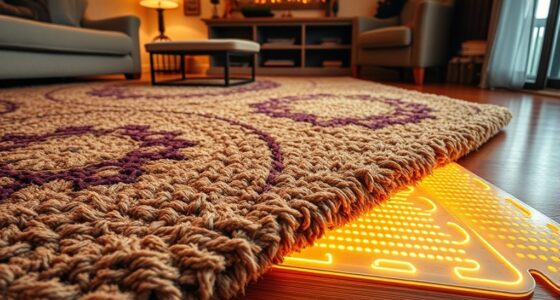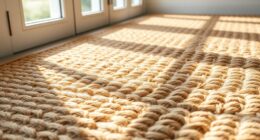In 2026, home wellness trends focus on rugs that actively boost your wellbeing with sustainable materials like wool, jute, and organic cotton. These rugs integrate smart technology, monitoring humidity, temperature, and foot traffic, then adjusting settings or activating calming features for relaxation. They’re designed to be antimicrobial and hypoallergenic, creating healthier indoor environments. If you want to discover more about how these innovative rugs can transform your space, keep exploring the latest in wellness flooring solutions.
Key Takeaways
- Wellness-oriented homes in 2026 feature rugs that promote relaxation, comfort, and holistic health through innovative design and technology.
- Eco-friendly rugs made from natural materials like wool, jute, and organic cotton support sustainability and improve indoor air quality.
- Smart rugs with embedded sensors monitor environmental conditions and automate adjustments to enhance wellbeing.
- Health-focused features such as antimicrobial fibers and hypoallergenic materials reduce allergens and promote cleaner indoor environments.
- Integration of smart technology and sustainable materials elevates daily comfort and supports holistic wellness in modern home design.

Have you noticed how more homes are transforming into wellness retreats? It’s no coincidence. People are increasingly prioritizing their health and comfort, creating spaces that nurture both mind and body. One trend gaining momentum in 2026 is the use of rugs that support wellbeing, blending sustainable design with smart home integration to enhance your living environment. These aren’t just decorative pieces; they’re carefully chosen elements that contribute to your overall wellness.
Sustainable design plays a central role here. More homeowners are opting for eco-friendly rugs made from natural, renewable materials like wool, jute, or organic cotton. These choices reduce environmental impact and often feature non-toxic dyes, ensuring better indoor air quality. When you select sustainable rugs, you’re making a conscious decision that benefits both the planet and your health. These rugs tend to be softer, more durable, and better at regulating indoor temperature, which adds to your comfort and sense of wellbeing.
Smart home integration takes this trend a step further. Imagine rugs embedded with subtle sensors that connect to your smart home system. These sensors can monitor your living environment, tracking things like humidity, temperature, and even foot traffic to optimize your space. For example, if the system detects that a particular area of your home is becoming too humid, it can automatically adjust your dehumidifier. Or, if you’re feeling stressed, your smart rug could activate calming lighting and play soothing sounds, creating a mini wellness sanctuary right in your living room.
This integration allows your rugs to do more than just sit on the floor. They become active participants in your wellness routine, promoting relaxation and comfort at the touch of a button or automatically based on your habits. Plus, many of these smart rugs incorporate antimicrobial or hypoallergenic fibers, which help reduce allergens and create healthier indoor air. This is especially beneficial if you suffer from allergies or respiratory issues, making your home a safer space for everyone.
The combination of sustainable design and smart home integration in wellness rugs isn’t just about aesthetics; it’s about functionality and health. It’s about creating a home environment that adapts to your needs, reduces your ecological footprint, and promotes mental and physical wellbeing. As you continue to personalize your space, consider these innovative rugs as a way to elevate your daily comfort and support your holistic health. They’re more than just floor coverings—they’re a smart, sustainable step toward a healthier, more mindful lifestyle. Additionally, the use of tracking technology in these rugs can help you better understand your daily habits and improve your overall wellness routine.
Frequently Asked Questions
How Do Eco-Friendly Rugs Improve Mental Health?
Eco-friendly rugs boost your mental health by creating a calming environment. Their sustainable manufacturing reduces environmental stress, while toxin-free dyes prevent harmful chemical exposure that can cause anxiety. When you choose these rugs, you embrace healthier living, feel more relaxed, and enjoy a cleaner space. This positive atmosphere helps lower stress levels and enhances your overall wellbeing, making your home a sanctuary for mental clarity and peace.
What Materials Are Best for Allergy-Sensitive Rugs?
For allergy-sensitive rugs, opt for natural materials like wool, cotton, or jute, which resist dust mites and allergens better than synthetic fibers. Avoid rugs treated with chemical treatments, as these can trigger allergies or sensitivities. If you choose synthetic fibers, look for those labeled hypoallergenic and free from harsh chemicals. Regular cleaning and avoiding synthetic coatings help guarantee your rug remains safe and comfortable for allergy sufferers.
Can Rug Designs Influence Relaxation and Focus?
Think of your rug as a silent guide to your mind’s landscape. Yes, rug designs can influence relaxation and focus through pattern psychology, creating calming visuals or stimulating energy. Rug texture also plays an essential role, with soft fibers soothing your senses. When you choose patterns and textures intentionally, you craft a space that nurtures your mental clarity and tranquility, making your home a true sanctuary.
How Often Should Wellness Rugs Be Cleaned?
You should clean your wellness rugs every 1 to 3 months, depending on usage and environment. Regular rug cleaning frequency helps maintain their supportive properties and keeps your space healthy. Follow maintenance tips like vacuuming weekly and spot cleaning spills promptly. Deep cleaning every few months guarantees dust, allergens, and dirt don’t build up, preserving your rug’s effectiveness in promoting relaxation and focus.
Are There Specific Colors That Promote Calmness?
While bold, vibrant hues can energize your space, soft, muted colors like blues, greens, and neutrals promote calmness through color therapy. These shades foster visual harmony, helping you relax and reduce stress. Opt for gentle tones in your wellness rugs to create a serene environment. The balance between lively and soothing colors influences your mood, so choose hues that resonate with your desire for tranquility and mental clarity.
Conclusion
Embrace the home wellness trend of 2026 and transform your space into a sanctuary so extraordinary, it practically elevates your very existence. These rugs don’t just support wellbeing—they redefine the boundaries of comfort and serenity, turning your home into an unrivaled haven of tranquility. With every step, you’ll feel an almost supernatural boost to your energy and peace. Prepare to live in a domain where wellness isn’t just a goal, but a breathtaking reality woven into every fiber of your home.








